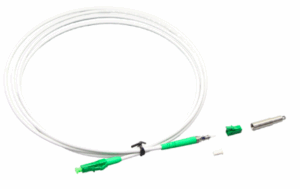The FTTH Drop Patch Cord is a crucial link between outdoor fiber distribution points and indoor terminals in fiber optic networks. Its durability under harsh environmental conditions is vital to maintaining network performance and minimizing downtime. These cords must withstand physical stress, extreme temperatures, ultraviolet (UV) exposure, moisture, and mechanical hazards. Selecting cables constructed with robust materials ensures long-term reliability and protects the network infrastructure investment.
Importance of Material Quality in FTTH Drop Patch Cord Performance
Material selection fundamentally influences both the mechanical strength and optical quality of an FTTH Drop Patch Cord.
- Outer Jackets for Environmental Protection
The outer jacket protects against UV radiation, flame, chemicals, and temperature fluctuations. LSZH (Low Smoke Zero Halogen) jackets are preferred for their flame retardancy and environmental safety. They maintain flexibility and mechanical integrity between –40°C and +85°C, even after extended outdoor exposure. This flexibility prevents cracking and embrittlement that could expose the fiber core to damage. - Strength Members for Mechanical Resistance
Strength members like aramid yarn or fiberglass rods provide essential tensile reinforcement, allowing the cable to withstand high pulling forces during installation without damaging the fiber. High-quality cords resist pulling forces over 300 Newtons, reducing the risk of fiber breakage when pulled through ducts or conduits. Tests show aramid-reinforced cords exhibit significantly lower elongation under stress compared to non-reinforced variants, ensuring stable network performance. - Fiber Coatings to Enhance Optical Performance
The fiber core is coated with UV-cured acrylate that guards against microbending and moisture ingress, both major causes of signal attenuation. These coatings help maintain insertion loss below 0.3 dB and return loss above 55 dB, even after repeated bending or environmental exposure. Studies indicate fibers with advanced coatings have up to 50% fewer degradation incidents in field use.

Key Features of FTTH Drop Patch Cord for Extreme Conditions
Certain characteristics are critical for FTTH Drop Patch Cords deployed in demanding environments.
- Waterproofing and Moisture Resistance
Outdoor-rated cords employ gel-filled buffer tubes and water-blocking tapes that form effective moisture barriers. Certified to IEC 60794 standards, these cables resist water ingress under 1 meter of submersion for 24 hours without optical performance loss. This waterproofing is essential for installations in areas prone to flooding, underground environments, or regions with high humidity. - Crush and Impact Resistance
Armored cables feature steel tape or corrugated steel armor designed to resist crush forces up to 1500 Newtons, effectively protecting against mechanical pressure and external impacts. This mechanical protection guards against damage from heavy equipment, accidental impacts, and rodent attacks, which are common risks in industrial or construction environments. - Temperature and Fire Resistance
Designed to operate reliably from –40°C to +85°C, these cords maintain optical and mechanical integrity across temperature extremes. Flame retardancy per IEC 60332-1 ensures compliance with indoor fire safety regulations, preventing flame propagation in case of fire.
Advantages of Ruggedized FTTH Drop Patch Cord Designs
- Reduced Downtime and Repair Frequency
The robust construction of ruggedized cords significantly decreases failures caused by mechanical damage. Field data shows a 70% reduction in network repair incidents when using armored, LSZH-jacketed cords, translating into higher service availability. - Cost Savings on Maintenance and Replacement
Despite a higher upfront cost, ruggedized cords’ extended service life—often exceeding 15 years outdoors—lowers total cost of ownership by reducing frequent replacements and maintenance labor. - Suitability for High-Density Installations
Their compact, yet strong design allows deployment in dense environments like multi-dwelling units (MDUs) or data centers, fitting narrow conduits without compromising mechanical robustness or optical performance. - Enhanced Environmental Durability
Resistant to UV radiation, moisture ingress, and temperature fluctuations, these cords reliably perform in coastal, desert, or industrial environments where conditions are especially challenging.
Standards and Certifications for FTTH Drop Patch Cord Durability

Meeting international standards guarantees the quality and reliability of FTTH Drop Patch Cords in harsh settings.
IEC 60794 certifies mechanical properties and environmental resistance, including crush, moisture, and temperature endurance. GR-20 and GR-326-CORE certifications validate connector and fiber durability under thermal cycling and mechanical stress. Additionally, RoHS and REACH compliance ensure the cables are free from hazardous substances and environmentally safe.
These standards guide network designers and operators in selecting cables that maintain performance and safety under demanding conditions, ensuring long-term operational success.
Conclusion
The durability of an FTTH Drop Patch Cord is paramount to maintaining stable, high-speed fiber networks in challenging environments. Selecting cables with UV-resistant LSZH jackets, high-strength aramid reinforcement, and sturdy armored protection significantly reduces failure rates, lowers maintenance needs, and extends service life. Prioritizing ruggedized, certified designs safeguards infrastructure investments and ensures reliable connectivity to end users even under the harshest conditions.
